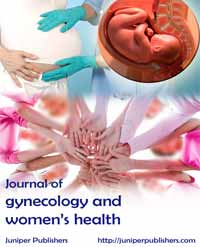Juniper Publishers : Ovarian Maldescent in Unicornuate Uterus; Diagnostic and Therapeutic Challenge
JUNIPER PUBLISHERS- JOURNAL OF GYNECOLOGY AND WOMEN’S HEALTH
Journal of Gynecology and Women’s Health-Juniper Publishers
Authored by Swati Verma*
Abstract
Undescended ovary is rare entity reported mainly in association with uterine anomalies. Most of the women are asymptomatic and diagnosis is established during infertility evaluation Knowing the presence of ectopic ovary is not only important from fertility point of view, it is also helpful in exploring certain clinical scenarios like cyclic abdominal pain, cyst formation or torsion, ruptured corpus luteum or acute abdomen. Magnetic Resonance Imaging is the most sensitive tool to locate undescended ovary and identify other associated uterine and renal anomalies.
Introduction
Developmental anomalies of ovaries are reported very infrequently. Although embryological development of ovaries is totally different from that of uterus and fallopian tubes, increased incidence of ovarian maldescent is very frequently reported in association with anomalies of mullerian tract [1,2]. Undescended or maldescended ovaries have an attachment to the area above the common iliac vessels and are more commonly associated with didelphys, hypoplastic and unicornuate uterus [3]. The incidence of undescended ovary is reported highest along with unicornuate uterus which is as high as 42% reported in some studies [2,3] Despite their established association with uterine malformations, many cases go unrecognised therefore true incidence of undescended ovaries is poorly reported. We hereby discuss a case of undescended ovary with unicornuate uterus in infertile women.
Case Study
Thirty year old female presented with primary infertility of 11 years. In previous evaluation for infertility, hysterosalpingography revealed right unicornuate uterus with gross dilatation of right fallopian tube and non-visualisation of left fallopian tube. Ultrasonography showed small size uterus, right ovary polycystic appearance, a big multicystic right adnexal mass which looks like right hydrosalpinx. Left ovary was not visible. She had history of laparoscopy done 2 years ago. Uterus was unicornuate with only right ovary visible with right hydrosalpinx. Cornual end of right hydrosalpinx was clipped. Left fallopian tube was not visible. Left ovary could not be seen in whole abdomen despite meticulous search. Her ovarian stimulation was done for IVF and she developed severe ovarian hyperstimulation syndrome. Ascitic fluid drainage was done twice and could not conceive after two attempts.
During present course of treatment, she was planned for IVF with antagonist protocol. After ovarian stimulation, there were 18-20 mature follicles of more than 16mm in the right ovary and GnRH agonist trigger (gonadotrophic releasing hormone) was given for maturation. On the day of maturation trigger, oestradiol levels were 14047 picogram/ml and total of 18 mature oocytes (M2) were retrieved from right ovary. After aspirating right ovary, an abdominal mass was visible in left lumber region during respiratory movements. On ultrasonography it was diagnosed as left ovary adjacent to left kidney, which showed 18-20 follicles of more than 16mm. These follicles were aspirated transabdominally and total of 26 grade I embryos were formed, which were cryopreserved. Three attempts of frozen embryo transfer were done after endometrium preparation. There was biochemical pregnancy in one and no pregnancy in two After this patient was lost to follow up.
Discussion
Undescended ovary results from the arrest of caudal descent during embryological period into the true pelvis. They can be unilateral or bilateral with reported incidence of 0.3 to 0.5% [3]. Unilateral undescended ovary is frequently seen on right side in retroperitoneal location. Although there is no reported increased incidence of infertility or malignancy in undescended ovary per se, establishing their existence is important for exploring certain clinical conditions and monitoring reproductive performance like ovarian hyperstimulation. These women may present with cyclic abdominal pain, cyst formation, ruptured corpus luteum or acute abdomen. Out of 30 cases of undescended ovary reported so far, 60% were asymptomatic. They were diagnosed during ovarian stimulation or infertility evaluation. Symptomatic ones (40%) presented mainly with acute surgical abdomen imitating ectopic pregnancy or torsion or mucocele or intestinal obstruction and had associated mullerian and renal anomalies [4,5].
Discrepancy between serum oestradiol level and number of follicles during ovarian stimulation along with uterine malformations should raise suspicion of an ectopic ovary. Magnetic Resonance Imaging (MRI) now a days is considered more sensitive than laparoscopy to diagnose undescended ovary. In a review of six cases of undescended (ectopic) ovary by Ombelet et al. [6], diagnosis could be established in three with MRI after ovarian stimulation. Another patient with unicornuate uterus and single ovary on left side was subjected to laparoscopy after multiple failures of intrauterine insemination ,but other ovary could not be located. Later on MRI performed in this patient after ovarian stimulation conformed the diagnosis of ectopic ovary on right side. In Index case also, ectopic ovary was missed out on laparoscopy probably due to its retroperitoneal location. Another clue in this case was disproportionality high serum oestradiol as compared to follicular growth. Ovarian hyperstimulation syndrome during first IVF cycle of this patient could be due to unmonitored unaspirated stimulated ectopic ovary.
Conclusion
In any women with mullerian anomalies with only one ovary visible, search should be made for abnormally located ovary. MRI not only accurate in diagnosing ectopic ovary, also detects associated urinary tract anomalies. Knowing the presence of ectopic ovary is not only important from fertility point of view, it is also helpful in managing certain clinical scenarios.
For more open access journals in JuniperPublishers please click on: https://juniperpublishers.com/
For more articles on Gynecology and Women’s Health please click on: https://juniperpublishers.com/jgwh/
To read more......Fulltext in Gynecology and Women’s Health in Juniper Publishers
https://juniperpublishers.business.site/




Comments
Post a Comment